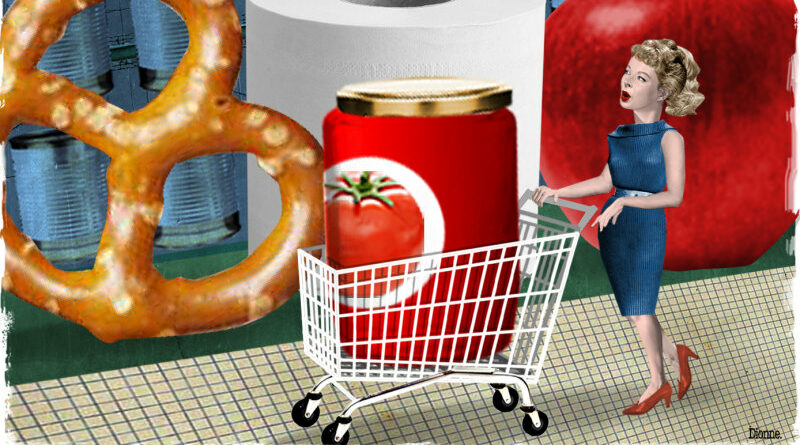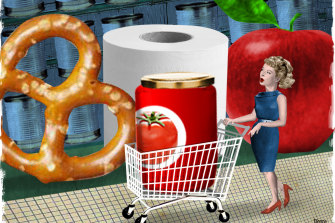Is Costco really cheaper than Woolies? Let’s find out
Grocery prices are set to rise, thanks to a ‘perfect storm’ of soaring fuel costs and supply disruptions. After a period in which the price of many everyday items like milk and bread actually fell (down, down, prices are down, remember?) this will be a shock to many household budgets.
One of the major factors driving down costs in recent years was the entry of new foreign supermarket brands like Aldi and Costco.
Y’all know I’m an Aldi fan, after I did an analysis which found it was about 10 per cent cheaper than Coles for my typical shop.
Giant tubs of salted pretzels, rolls and rolls of toilet paper: You have to buy them all in bulk, which can be challenging for single-person or small households.Credit:Dionne Gain
This week, I decided to check out Costco for the first time to run a similar analysis. I’ll get to the results of that. But first, here are my top tips for getting the most out of a Costco trip.
First, go to university for four years and land a job at Australia’s most prestigious newspapers. After 17 years, reach a level of seniority where it is actually your job to go to Costco and write about it.
Alternatively, just get in the car and go!
Upon arrival, resist the lure of a $1.99 hotdog or $6.99 Banh Mi at the IKEA-style eatery out-front and proceed straight to the membership counter.
As you wait in line, try to ignore the disconcerting sight of sample coffins in the Costco ‘coffins, caskets and urns’ display. This is almost certainly a clever marketing ploy to put you in a “YOLO” (you only live once) frame-of-mind before you shop.
Annual membership to Costco – you must have it to buy anything – costs $60 per year for households or $55 for businesses. All you need is an Australian Business Number to get the business membership – even if you openly confess to the Costco assistant your only business is “occasional creative writing and public speaking”.
Next, wheel your supersized trolley into the entrance and try not to immediately buy a pair of 1.64 carat diamond drop earrings for $4,479.99, or the adjacent 4.43 litre bottle of laundry detergent for $31.99 because: a) how weird is it they sell diamonds? and b) Coles often sells 2-litre bottles of detergent for $10, and that’s cheaper.
Pause briefly – somewhat overwhelmed – under the shadow of three-storey high warehouse shelves stocking everything from hearing aids to coffee machines to tents. Then pull yourself together and head to the back of the store for fresh food.
At least, that’s how it went for me.
I ended up spending $421.60 on food and household items (not including the membership fee).
That’s a big shop for me.
When I got home, I created an Excel spreadsheet listing everything I bought and began scouring the Woolworths website for comparable prices for comparable quantities.
I ran two analyses. The first compared the Costco items I had purchased to their same-brand or equivalent-branded product at Woolworths. I couldn’t find up-to-date prices for brussels sprouts and pork mince, so I just gave Woolworths the benefit of the doubt and entered the same Costco price.
Just like the food you eat, a bit of variety in your store shopping habits can be very a good thing.
My Woolworths cart came out significantly more expensive at $541.92, implying a Costco ‘saving’ of a whopping $120.32.
But unlike Costco, Woolworths and Coles typically offer a choice of brands plus their ‘homebrand’ alternatives, which are of generally good quality and price.
So, in my second analysis, I compared my Costco prices to the Woolworths homebrand substitutes.
Woolworths still came out more expensive, but less so, at $488.24. Given I actually dropped $476.60 in total to shop at Costco (including the membership) it’s not clear I was that much better off (although future Costco trips would reduce the per-visit cost of membership).
So yes, on balance, Costco came out cheaper. But there are several important caveats to that.
First, there is no guarantee that Costco is cheaper on every item. Costco fresh salmon, at $31.99 per kilogram, cost more than Woolworth’s $27 per kilogram.
The 1-kilogram tub of salted pretzels I bought because I was sure it would be cheaper at $11.39 actually cost more than if I’d bought five 200 gram bags for $2 each at Woolworths.
And I forked over $19.99 for a 1.2 kilograms packet of strawberries at Costco, when I could have paid $18.72 for the same amount at Woolworths. Importantly, I could also have just bought a smaller punnet.
There were some substantial Costco savings, however. I paid just $7 per kilo for pork sausages on special, compared to $10 at Woolworths. A 620 gram tub of ‘all purpose’ seasoning cost me just $11.99, compared to $18.91 for the same amount at Woolworths. Popcorn, toilet paper, chicken thighs, blueberries, capsicums and carrots were all noticeably cheaper.
Only problem is you have to buy them all in bulk, which can be challenging for single-person or small households, such as mine.
Bottom line, I’d say Costco is great for stocking up on long-life shelf items in bulk and there are definitely savings to be had on fruit and vegetables for large families who can buy in bulk and be sure not to waste it before it goes off.
But you also have to factor in your time, how close you live to a Costco and your personal preferences for organic or low-plastic packaged food.
Everyone should keep an eye out for half-priced specials at Coles and Woolworths and stock up on any commonly used items.
And check out Aldi, too, because their knock-off brands are often the cheapest of all. Their ‘Teddy Tots’ take on Tiny Teddies, for example, would have cost me $10.46 for 42 mini packets, compared to Costco’s $11.48 and Woolworth’s $14.
Just like the food you eat, a bit of variety in your store shopping habits can be very a good thing.
But if you’ll excuse me, I’ve got a kilogram of strawberries left to eat…
- Advice given in this article is general in nature and is not intended to influence readers’ decisions about investing or financial products. They should always seek their own professional advice that takes into account their own personal circumstances before making any financial decisions.
Jessica Irvine is author of the new book Money with Jess: Your Ultimate Guide to Household Budgeting. You can follow more of Jess’ money adventures on Instagram @moneywithjess and sign up to receive her weekly email newsletter.
Most Viewed in Money
From our partners
Source: Read Full Article



